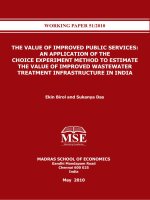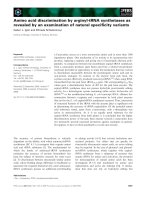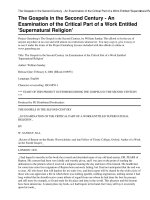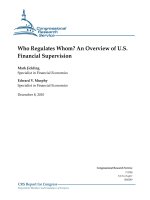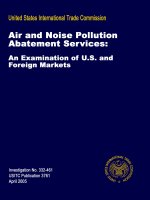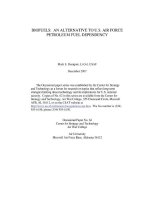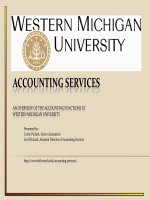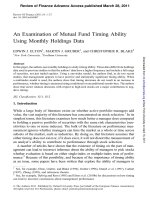Air and Noise Pollution Abatement Services: An Examination of U.S. and Foreign Markets ppt
Bạn đang xem bản rút gọn của tài liệu. Xem và tải ngay bản đầy đủ của tài liệu tại đây (2.31 MB, 182 trang )
U.S. International Trade Commission
Robert A. Rogowsky
Director of Operations
COMMISSIONERS
Address all communications to
Secretary to the Commission
United States International Trade Commission
Washington, DC 20436
Deanna Tanner Okun, Vice Chairman
Stephen Koplan, Chairman
Marcia E. Miller
Jennifer A. Hillman
Charlotte R. Lane
Daniel R. Pearson
Karen Laney-Cummings
Director of Industries
U.S. International Trade Commission
Washington, DC 20436
April 2005
www.usitc.gov
Publication 3761
Air and Noise Pollution
Abatement Services:
An Examination of U.S. and Foreign Markets
Investigation No. 332-461
This report was principally prepared by the Office of Industries
Project Team
Jennifer Baumert, Project Leader
Eric Forden, Deputy Project Leader
Judith Dean, Economist
Staff assigned:
William Chadwick, Lisa Ferens, David Ingersoll, Dennis Luther, Christopher Mapes,
Erick Oh, Rober t Randall, and Ben Randol
Office of Operations
Peg MacKnight
With special assistance from:
Lynette Gabourel and Cynthia Payne
Primary Reviewers
Alan Fox and Mark Paulson
under the direction of
Richard Brown, Chief
Services and Investment Division
i
ABSTRACT
As requested by the United States Trade Representative (USTR), this report examines
global markets for air and noise pollution abatement services and trade in these services
markets for the purpose of providing information that would be useful in conducting
trade negotiations and environmental reviews. The report indicates that demand for air
and noise pollution abatement services is driven largely by government regulation and
enforcement efforts, and to a lesser extent, by international treaty obligations, public
sentiment, and private-sector financial resources. The majority of air pollution abatement
services are reportedly delivered in conjunction with air pollution control equipment,
with European, Japanese, and U.S. firms being the dominant suppliers of such services
and equipment. Emissions trading, a financial service associated with air pollution
abatement, is a newly emerging market that is gaining acceptance in developed
countries. The market for noise pollution abatement services is small, as such pollution
is often addressed through product standards, environmental and labor regulation,
scheduling, and zoning restrictions.
iii
Table of Contents
Page
Abstract i
Executive summary vii
Acronyms and chemicals symbols ix
Chapter 1. Introduction 1-1
Purpose 1-1
Air pollution abatement 1-2
Noise pollution abatement 1-3
Air and noise pollution abatement services in the World Trade Organization 1-4
Scope 1-4
Methodological approach 1-5
Organization 1-9
Chapter 2. Literature review 2-1
Monitoring and testing 2-1
Impact of monitoring and enforcement on environmental performance 2-1
Impact of public disclosure programs 2-3
Permit trading 2-4
Efficiency in design 2-5
Effectiveness in practice 2-6
Abatement technology 2-8
Impact of environmental regulations on technological innovation and diffusion 2-8
Type of environmental regulation and technological innovation and diffusion 2-10
References 2-11
Chapter 3. Factors affecting supply and demand 3-1
Factors affecting supply 3-1
Factors affecting demand 3-2
iv
Table of Contents–Continued
Page
Chapter 4. Air pollution abatement services
and equipment 4-1
Technologies and methods 4-3
Market size and characteristics 4-5
Key suppliers and consumers 4-8
Related equipment 4-9
Trade and investment 4-10
Chapter 5. Emissions trading 5-1
Introduction 5-1
Market segments 5-3
The U.S. Acid Rain Program (U.S. SO
2
Program ) 5-4
The European Union Emissions Trading Scheme (EU ETS) 5-9
Overview 5-9
Market characteristics 5-11
Market participants 5-12
Market activity 5-14
The United Kingdom Emissions Trading Scheme (UK-ETS) 5-16
Chicago Climate Exchange (CCX) 5-17
Trade and investment 5-18
Market outlook 5-21
Chapter 6. Noise pollution abatement services
and equipment
6-1
Introduction 6-1
Technologies and methods 6-2
Market size and characteristics 6-5
Key suppliers and consumers 6-6
Related equipment 6-6
Trade and investment 6-7
Chapter 7. Summary of findings 7-1
v
Table of Contents–Continued
Page
Appendices
A. Request letter A-1
B. Federal Register notice B-1
C. Cleaning services of exhaust gases and noise abatement services in the General
Agreement on Trade in Services C-1
D. Country summaries D-1
E. Position of interested party E-1
F. Glossary F-1
Boxes
4-1. U.S. EPA-listed industrial emitters equipment, sorted by OECD classification 4-11
5-1. Emissions trading vs. command-and-control: Examples of potential cost savings 5-3
5-2. Regional emissions trading schemes 5-7
5-3. Anatomy of an EUA brokered trade 5-13
Figures
1-1. Air and noise pollution abatement services: Core and cluster services 1-6
3-1. GDP per capita and industry perceptions of air pollution regulations, by country, 2003 3-7
3-2. Per capita GDP and CO
2
emissions, by country, 2002 3-8
5-1. U.S. SO
2
Program, allowances prices and volumes arranged through brokers,
January 2002-January 2005 5-10
5-2. EU emissions trading scheme, EU allowance prices and volumes arranged through
brokers, July 2003-January 2005 5-15
5-3. Chicago Climate Exchange, volumes by month and vintage, 2004 5-19
5-4. Chicago Climate Exchanges prices and volumes traded during January 2004-
December 2004 5-20
Tables
1-1. Data sources: Air and noise pollution abatement 1-8
3-1. Factors affecting supply and demand in the air and noise pollution abatement services and
goods industries 3-12
4-1. Characteristic of selected country markets for air pollution abatement services
and goods 4-14
5-1. Comparison of emissions trading schemes 5-5
OMB No.: 3117 0188
04/05
ITC READER SATISFACTION SURVEY
Air and Noise Pollution Abatement Services:
An Examination of U.S. and Foreign Markets
The U.S. International Trade Commission (USITC) is interested in your voluntary com-
ments (burden less than 10 minutes) to help assess the value and quality of our reports, and to assist
in improving future products. Please return survey by facsimile (202-205-2359) or by mail to the
USITC, or visit the USITC Internet home page
( to electronically submit a Web version of
the survey.
(Please print; responses below not for attribution):
Your name and title:
Organization (if applicable):
Which format is most useful to you? - CD-ROM - Hardcopy - USITC Internet site
Circle your assessment of each factor below: SA = strongly agree, A = agree, N =noopinion,
D = disagree, or SD = strongly disagree.
Value of this report:
" Statistical data are useful SA A N D SD
" Other non-numerical facts are useful SA A N D SD
" Analysis augments statistical data/other facts SA A N D SD
" Relevant topic(s)/subject matter SA A N D SD
" Primary or leading source of information on this subject SA A N D SD
Quality of this report:
" Clearly written SA A N D SD
" Key issues are addressed SA A N D SD
" Charts and graphs aid understanding SA A N D SD
" References cite pertinent sources SA A N D SD
Other preferred source of information on this subject:
Specify chapters, sections, or topics in report that are most useful:
Identify any type of additional information that should have been included in report:
Suggestions for improving report:
Please update your mailing and electronic addresses below (voluntary)-
Mailing a ddress:
City, state, and zip code:
E-mail address:
UNITED STATES
INTERNATIONAL TRADE COMMISSION
WASHINGTON, DC 20436
OFFICIAL BUSINESS
PENALTY FOR PRIVATE, USE $300
FOLD
NO POSTAGE
NECESSARY
IF MAILED
IN THE
UNITED STATES
BUSINESS REPLY MAIL
FIRST CLASS PERMIT NO. 12840 WASHINGTON, DC
POSTAGE WILL BE PAID BY ADDRESSEE
U.S INTERNATIONAL TRADE COMMISSION
500 E STREET, SW.
WASHINGTON, DC 20277 2840
ATTN:
OFFICE OF INDUSTRIES
Air and Noise Pollution Abatement Services:
An Examination of U.S. and Foreign Markets
vii
EXECUTIVE SUMMARY
Demand for air pollution abatement services and equipment is driven largely by
government regulation and enforcement activities and, to a lesser extent, international
obligations, financial resources, and public sentiment. In most countries, air pollution
regulations limit emissions on a range of air pollutants. Regulatory regimes and
enforcement measures in developed countries are typically more stringent, compared to
developing countries. Evidence indicates that as incomes grow, regulatory stringency
increases, driving demand for air pollution goods and services. In developed countries,
while air pollution regulations have generally been passed at the national level,
implementation and enforcement action is being devolved to subnational governments.
By contrast, developing countries tend to enact, implement, and enforce air pollution
control regulations at the national level. This distinction may impact the provision of
goods and services, as providers may be forced to comply with several different sets of
standards among states, rather than just one set of regulations at the national level.
Noise pollution abatement also is driven by government regulations. In most countries,
noise pollution is typically a low priority issue, although laws and regulations in this
sector tend to be more advanced in developed countries. Noise pollution is often
addressed by product standards and/or environmental and labor laws.
Air pollution abatement goods and services are frequently supplied to customers as part
of a single transaction, with goods accounting for the majority of the sale. In addition,
a significant share of the services provided to abate air pollution are classified in
industries other than the core air pollution abatement services sector, such as engineering
and construction. Markets for air pollution abatement goods and services in developed
countries tend to be highly competitive and are supplied by several hundred small,
private-sector firms. By contrast, developing countries are reliant upon imports of such
goods and services, often resulting in a limited selection in terms of technology, cost,
and suitability for pollution control requirements. Nonetheless, many developing-
country markets, including China, India, Poland, and Turkey, are considered to offer
good prospects for growth.
The United States, the European Union, China, and Japan are the largest consumers of
air pollution abatement services and equipment accounting for approximately 28 percent,
18 percent, 15 percent, and 6 percent of this combined market, respectively. U.S. firms
are estimated to be the dominant suppliers of air pollution abatement services in the
world market, while firms from the European Union are likely the dominant suppliers
of core air pollution abatement equipment. Overall, there are few trade barriers in either
developed-or developing-country markets directly related to air pollution abatement
services. Tariff rates on air pollution abatement equipment in developed countries tend
to be lower than such tariffs in developing countries. There are no discrete data on
investment in the air pollution abatement services and goods sectors.
Emissions permit trading is a market-based alternative to the traditional command-and-
control approach to air pollution abatement, under which regulatory authorities compel
polluters to install cleaner technologies or attain source-specific emissions reductions.
Although command-and-control regulations remain the principal means of addressing
air pollution, emissions permit trading is gaining acceptance as a method for reducing
air pollution, primarily in the United States and Europe. The primary approach to
viii
emissions trading is the “cap and trade” approach. Under such an approach, a regulatory
authority establishes a desired “cap” on the overall amount of a specific air pollutant
emitted by a group of installations during a compliance period. Emissions allowances
are allocated among affected installations, with the total number of issued allowances
equaling the desired cap. At the end of the compliance period, each installation must
possess allowances sufficient to cover its emissions during the period. Installations
whose emissions fall below the initial allowance allocation may sell excess allowances
on an emissions market. Similarly, installations whose emissions exceed the initial
allowance allocation must purchase additional allowances in the emissions market. With
the exception of the U.S. Acid Rain Program, emissions trading markets are in the early
stages of development, and thus, it is unclear what effect these programs will have on
the overall market for air pollution abatement goods and services. The European Union
Emissions Trading Scheme, which was launched in January 2005, is the most prominent
scheme focused on reducing greenhouse gases. Other schemes include the United
Kingdom Emissions Trading Scheme, the New South Wales Greenhouse Gas Abatement
Scheme, the NO
x
Budget Trading Program, and the Chicago Climate Exchange.
The global market for noise pollution abatement services, which is largely confined to
testing, measurement, and modeling activities, is extremely small. Providers of such
services are almost entirely composed of small, specialized engineering and/or
consulting firms. Equipment related to the provision of such services includes measuring
and testing equipment, associated computer equipment, and computer software. There
are no discrete data on trade and investment in the noise pollution abatement services
market. However, the reportedly unprofitable nature of the noise pollution abatement
services and equipment markets, combined with the tendency for such services to be
provided by local suppliers, suggest that there is likely very little, if any, international
trade in noise pollution abatement services.
ix
ACRONYMS AND CHEMICAL
SYMBOLS
AAU Assigned amount unit
APC Air pollution control
ATDS Automotive Testing and Development Systems
BACT Best available control technology
BNA Bureau of National Affairs
BP British Petroleum
CAA Clean Air Act (United States)
CAIR Clean Air Intersate Rule
CBOT Chicago Board of Trade
CCAD Comisión Centroamericana de Ambiente y Desarrollo
CCAP Climate change agreement participants
CCX Chicago Climate Exchange
CDC Centers for Disease Control and Prevention
CDM Clean Development Machanism
CEPA Canadian Environmental Protection Act, The
CER Certified emission reductions
CFC Chlorofluorocarbons
CFI Carbon Financial Instruments
CH
4
Methane
CICA Centro de Investigacion Contaminacion Ambiental
CO Carbon monoxide
CO
2
Carbon dioxide
CO
2
e Carbon dioxide equivalent
CONAMA Conselho Ncaional de Meio Ambiente (Brazil)
CPC Central Product Classification
DEAT Department of Environmental Affairs and Tourism (South
Africa)
DOE Department of Energy
DP Direct participants
x
EAS EnriroSafe Australia
EBI Environmental Business International
EC European Communities
ECX Eurpean Climate Exchange
EEA Energy and Environment Analysis, Inc.
EEX European Energy Exchange
EFET European Federation of Energy Traders
EGAT Electricity Generating Authority of Thailand, The (Thailand)
EIA Energy Information Administration
EPA Environmental Protection Agency
ERU Emissions reduction units
ESP Electrostatic precipitator
EU European Union
EU-12 Belgium, Denmark, France, Germany, Greece, Ireland, Italy,
Luxembourg, Netherlands, Portugal, Spain, and the United
Kingdom
EU-15 EU-12 and Austria, Finland, and Sweden
EU-25 EU-15 and Cyprus, Czech Republic, Estonia, Hungary, Latvia,
Lithuania, Malta, Poland, Slovakia, and Slovenia
EU-ETS EU Emission Tradeing Scheme
EUA European Union allowance
EXAA Austrian Energy Exchange
FGD Flue gas desulfurization
FIC Foreign Investment Committee, The (Chile)
FIRB Foreign Investment Board
FTA Free Trade Agreement
GAO General Accounting Office
GATS General Agreement on Trade in Services
GCR Global Competitiveness Report, The
GDP Gross domestic product
GHG Greenhouse gases
GWP Global Warming Potential
H
2
O Water
xi
H
2
SO
4
Sulfuric acid
HAPS Hazardous air pollutants
HFCs Hydroflurocarbons
HS Harmonized System of Product Classification, The
HTK Hotaka Engineering
IAP Indoor air pollution
IBAMA Brazilian Institute of the Environment and Renewable Natural
Resources (Brazil)
ICE Centro Nacional de Planificacioin Electrica
IETA International Emissions Trading Association
INPI National Institute for Industrial Property (Brazil)
IPE International Petroleum Exchange
ISDA Internal Swaps and Derivatives Association, Inc.
ISO International Organization for Standardization
JI Joint Implementation
LINCOS
Little Intelligent Communities
MARPOL Protocol of 1978 Relating to the International Convention for
the Prevention of Pollution From Ships, 1973 (Korea)
MERCOSUL Mercado Comum do Su, The
MFN Most-favored-nation
MMA Misisterio do Meio Ambiante, The (Brazil)
MVR Montly Violations Reports
N
2
O Nitrous oxide
NAAQS National Ambient Air Quality Standard
NAP National Allocatoin Plan
NBP NO
x
Budget Trading Program
NEMA National Environmental Management Act (South Africa)
NGO Non-Government Organization
NO Nitric oxide
NO
2
Nitrogen dioxide
NOM Normas Officialas (Mexico)
NO
x
Nitrogen oxides
NSW Scheme New South Wales GReenhouse Gas Abatement Scheme
xii
O
3
Ozone
OECD Organization for Economic Cooperation and Development
OSHA Occupational Safety and Health Act of 1970, The (United
States)
PCV Positive crankcase ventilation
PEMEX Petroleos Mexicanos (Mexico)
PERS Porous elastic road surface
PERT Pilot Emission Reduction Trading (Canada)
PFCs Perfluorocarbons
PM Particulate matter
PM
10
Particles with a diameter of 10 microns or less
PM
2.5
Particles with a diameter of 2.5 microns or less
PPDA Atmosphere Prevention and Decontamination Plan for the
Metropolitan Region
PROPER Program for Pollution Control, Evaluation and Rating
PRTR Law Pollution Release and Transfer Registry Law (Japan)
R&D Research and development
RECLAIM Regional Clean AIr Incentives Market
RECOPE Refinadora Costarricense de Petr
óleo
RFG Reformulated gasolines
RGGI Regional Greenhouse Gas Initiative
RWDI Rowan Williams Davies & Irwin, Inc.
SAIC Science Application International Corporation (Mexico)
SCR Selective catalytic reduction (United States)
SEMARNAT Ministry of the Enviroment and Natural Resources (Mexico)
SESMA Servicio de Salud Metropolitan del Ambiente (Chile)
SF
6
Sulphur hexaflouride
SO
2
Sulfur dioxide
SO
3
Sulfur trioxide
SO
x
Sulfur oxides
STPS Ministry of Labor and Social Security, The (Mexico)
TRI U.S. Toxic Release Inventory
UK United Kingdom
xiii
UK-ETS United Kingdom Emission Trading Scheme
UKA United Kingdom allowances
UKA United Kingdom allowance
UNCTAD United Nations Conference on Trade and Development
UNFCCC United Nations Framework Convention on Climate Change
USDOC United States Department of Commerce
USFCS U.S. Foreign Commercial Service
USITC United States International Trade Commission
USTR United States Trade Representative
VOC Volatile organic compounds
WHO World Health Organization
WITS World Integrated Trade Solution
WRI World Resources Institute
WTO World Trade Organization
1
As identified under section 332(g) of the Tariff Act of 1930.
2
See appendix A.
3
The Federal Register Notice pertaining to this investigation can be found in appendix B.
4
Such regulatory practices may include national and subnational environmental
regulations, as well as multinational conventions or agreements on environmental issues that
may have an effect on the air and noise pollution abatement services markets.
5
For the purposes of this report, “developed” countries include those considered by the
World Bank to be high-income economies. World Bank, 2003 World Development Indicators
(World Bank: Washington D.C., 2003).
6
For the purposes of this report, ‘developing’ countries include those considered by the
World Bank to be low- and middle-income economies. World Bank, 2003 World
Development Indicators (World Bank: Washington D.C., 2003).
1-1
CHAPTER 1
INTRODUCTION
Purpose
On July 12, 2004, the U.S. International Trade Commission (Commission or USITC)
received a request from the United States Trade Representative (USTR) to conduct two
investigations
1
and provide two reports that would examine discrete segments of the
environmental and energy services industries. The first investigation is to focus on air
and noise pollution abatement services, and the second is to focus on renewable energy.
2
The findings of this investigation, Air and Noise Pollution Abatement Services: An
Examination of U.S. and Foreign Markets (Inv. No. 332-461),
3
are presented in this
report. As requested by the USTR, this report provides an overview of U.S. and foreign
markets for air and noise pollution abatement services; examines trade and investment
in these markets, including barriers affecting such trade and investment, if any; and
where possible, discusses existing regulatory practices that generate demand for the
subject services.
4
The report provides information on both developed-
5
and
developing-country
6
markets for air and noise pollution abatement services, and includes
examples—as appropriate—from those economies with which the United States has
established, or is in the process of negotiating, a free trade agreement.
As requested, the report also includes, to the extent possible, information on trade and
market conditions for those goods related to the subject environmental services. Air and
noise pollution abatement services are frequently economic complements to air and
noise pollution abatement goods. For example, many air pollution abatement projects
are unique applications that involve services such as engineering consulting to design
unique equipment, which then may be fabricated and installed by the same or another
firm. Within these industry sectors, goods include a wide variety of equipment and
mechanical devices that reduce, prevent, capture, or destroy pollutants before they are
released into the atmosphere. Examples of such equipment applicable to air pollution
include scrubbers, which remove harmful gases and particulates from exhaust gases;
incinerators (or thermal oxidizers), which use intense heat to destroy organic
contaminants; filter collectors, which trap and remove particulates from an exhaust
stream; and catalysts, which cause chemical reactions that break the pollutants down into
7
Generally, data provided by the McIlvaine Company are based on industry estimates. The
McIlvaine Company, e-mail received by Commission staff, Dec. 29, 2004. A fuller discussion
of all the data presented in this report is found under the heading Methodological Approach,
which concludes this chapter.
8
The McIlvaine Company, e-mail received by Commission staff, Dec. 29, 2004.
9
Includes goods and services in pollution control sectors in addition to air and noise.
Sandeep Singh, “Trade and Environment Set to Lock Horns at WTO,” The Financial Express,
Feb. 3, 2003, found at retrieved Jan. 27, 2005.
10
The McIlvaine Company, World Air Pollution Control Revenue Forecasts, p. 9,
document sent to USITC staff via e-mail, received Jan. 4, 2005.
11
Environmental Business International, Inc. (EBI), 1996, found at ,
retrieved Jan. 6, 2005.
12
SO
x
, oxides of sulfur, includes primarily sulfur dioxide (SO
2
) and sulfur trioxide (SO
3
).
SO
2
forms when sulfur (all fossil fuels contain sulfur) is burned. The resulting fine particulate
matter pollution can inhibit visibility, lead to acid rain, and adversely affect human health.
13
NO
x
, oxides of nitrogen, includes primarily nitrogen dioxide (NO
2
) and nitric oxide
(NO). NO
2
is a respiratory irritant, and also a precursor to ozone (smog) formation. The main
source of NO
x
emissions are combustion sources, such as cars, power plants, and industrial
engines. U.S. Environmental Protection Agency (EPA), found at
retrieved Dec. 28, 2004.
1-2
less harmful by-products. Goods applicable to noise pollution include engine mufflers,
highway noise barriers, and ear plugs and other hearing protectors.
Air Pollution Abatement
The worldwide market for air pollution abatement services has increased steadily in
recent years, registering, according to one industry source, an average annual growth rate
of approximately 6 percent during the period 1994-2004, and reaching an estimated $2.4
billion in 2004.
7
The worldwide market for air pollution abatement goods is estimated
to have experienced similar growth (7 percent) during the same period, although the
overall market size for goods is considerably larger, reaching an estimated $49.4 billion
in 2004.
8
The United States is the world’s largest producer and exporter of air pollution
control equipment and services, followed by Japan and Germany. Together, the United
States, Japan, and the EU account for an estimated 85 percent of world trade in the
overall pollution control industry.
9
Looking specifically at air pollution abatement goods
and services, industry sources indicate that Germany, Japan, and the United States are
major exporters.
10
In general, developing countries are most frequently importers of air
pollution abatement goods and services, while large developed countries are typically
exporters. Consumers of air pollution control equipment vary by market, but generally,
electric utilities, by far, purchase the largest share in many markets. Other significant
clients include the chemical, pharmaceutical, and plastics industries; petroleum refining;
pulp and paper manufacturing firms; incinerators; and large-scale foundries.
11
Air pollution abatement services focus on the reduction and control of a variety of
pollutants such as sulfur oxides (SO
x
),
12
nitrogen oxides (NO
x
),
13
lead, carbon monoxide
(CO), ozone (O
3
), particulate matter (PM), hazardous air pollutants, greenhouse gases
14
Greenhouse Gases (GHGs) allow sunlight to reach the earth’s surface, but restrict
infrared energy (heat) from escaping into space. The six greenhouse gases addressed by the
Kyoto Protocol are: carbon dioxide (CO
2
), methane (CH
4
), nitrous oxide (N
2
O),
hydrofluorocarbons (HFCs), perfluorocarbons (PFCs), and sulphur hexafluoride (SF
6
). Each
gas has a different global warming potential and longevity in the atmosphere.
15
Industry representatives, interviews by USITC staff, Bangkok, Seoul, and Tokyo, Nov.
2004.
16
Generally, emissions trading allows an entity that wishes to release emissions in excess
of their allotted level to buy unused polluter entitlements from other enterprises emitting
below their allotted levels. Emissions trading may lead to increased demand for air pollution
abatement goods and services. For example, industry representatives expect the EU Emissions
Trading Scheme (EU-ETS) to create demand of air pollution abatement services and
equipment, as the newly restricted firms move to avoid fines and other penalties. Technically
speaking, the regulatory measures requiring emissions reduction are the industry driver, while
programs such as the EU-ETS are more-or-less byproducts of the laws.
17
Industry representatives, interviews by USITC staff, Tokyo and Seoul, Nov. 2004.
18
One established benchmark comes from the Deafness Research Foundation, which
reports that prolonged exposure to noise above 85 decibels can cause hearing loss. The World
Health Organization (WHO) reports that noise pollution negatively affects health and
well-being and is considered a serious health problem worldwide. In addition to hearing loss,
other health effects of noise include stress, anxiety, poor concentration, and loss of
productivity.
1-3
(GHGs), and myriad indoor air pollutants.
14
Demand for such services is expected to
increase in regions experiencing increased instances of air pollution, and where the
public has expressed concern regarding environmental conditions as they relate to health
and quality of life.
15
Such factors combine to spur legislation and other actions that serve
to ameliorate air pollution, which, in turn, often spur demand for air pollution abatement
goods and services. Air pollution policies may be established at the national or
subnational levels, and may take the form of emission limits on individual industrial
polluters, processes, or vehicles; air quality threshold goals and objectives; or economic
instruments such as energy and pollution taxes, or emissions trading schemes.
16
Noise Pollution Abatement
The global market for services related to noise pollution abatement is believed to be
small, as it is essentially confined to various testing, measuring, and modeling activities
that might be done by outside contractors or consultants. Anecdotal information suggests
that the worldwide market for noise pollution abatement goods and services has grown
in recent years. However, quantitative information covering these industry segments is
generally limited and incomplete, precluding precise statistical analysis.
17
The Centers for Disease Control and Prevention (CDC) reports that noise has become
one of the most pervasive environmental pollutants in today’s society, requiring
increased attention. However, noise restrictions are difficult to manage and enforce
because noise pollution is much more subjective than many other environmental
pollutants. For most, a loud fireworks display is usually considered an enjoyable event,
but the same audience would probably consider the same noise a nuisance if trying to
sleep. Criteria that are not subject to personal opinion
18
are generally the most useful
when crafting laws, ordinances, and standards relating to noise control. Thus, when
possible, noise control policies usually are based on objective performance standards,
19
Solutions may involve protecting the recipient, increasing path length, blocking the path,
or reducing the noise at the source.
20
World Trade Organization (WTO), Ministerial Declaration: Adopted on 14 November
2001, WT/MIN(01)/DEC/1, Nov. 20, 2001.
21
Industry representative, interview by USITC staff, California, May 11, 2004.
22
WTO, MTN.GNS/W/120, July 10, 1991.
1-4
which may specify maximum noise emission levels for certain types of equipment, such
as motorcycles, and for the performance of specific activities, such as building
construction. Other controls include measures such as local ordinances that restrict
certain noises to certain times of day. Regulations relating to noise pollution exist at the
national, state, and local levels, and may be directed toward the source of the offending
noise, the path of noise transmission, and the targeted observer.
19
Air and Noise Pollution Abatement Services in the
World Trade Organization (WTO)
The air and noise pollution abatement services industries, as discrete segments of the
overall environmental services sector, have received special emphasis in the WTO, as
the reduction or elimination of barriers affecting trade in environmental services has
been identified in the Doha Ministerial Declaration
20
as one of the principal goals of the
present negotiating round. Industry representatives believe that as trade in the
environmental service sector expands globally, exporters, importers, and the
environment itself may benefit from increased competition that generally reduces costs,
increases service quality, improves efficiency, and/or introduces environmental services
that were previously unavailable.
21
Environmental issues also have become increasingly
tied to international trade and investment activities, such that the potential environmental
impact of a trade agreement is increasingly likely to be evaluated by the participating
national governments and considered as a critical element of the agreement under
consideration.
Scope
For the purpose of this study, air and noise pollution abatement services are defined to
include control services of indoor or outdoor air pollution originating from stationary
or mobile sources; services related to the trade of air pollution emission rights; services
related to the monitoring, assessment, or control of acid rain; services related to the
study of the relationship between air pollution and climate; noise pollution abatement
and control services; testing and monitoring of air or noise pollution; and other services
incidental to air and noise pollution abatement. The USTR specified this definition of
the air and noise pollution abatement services industries in its request letter. Other
researchers may arrive at different, but equally valid, definitions of air and noise
pollution abatement services.
One of the characteristics of the definition utilized in this investigation is that it is largely
based on the World Trade Organization’s (WTO) Services Sectoral Classification List
22
(also known as the W/120), which is used by most signatories to the General Agreement
23
The terms and conditions under which WTO signatories accord market access and
national treatment to foreign firms are provided within national schedules of specific
commitments.
24
For more information regarding GATS commitments on cleaning services of exhaust
gases (CPC 9404) and noise abatement services (CPC 9405) as well as a discussion of recent
developments in the WTO as they relate to these service segments, see appendix C.
25
While industry segments can be differentiated for classification purposes, most data used
in this report includes both core and periphery services, as data collection capabilities
currently do not allow a more narrow examination.
26
Organization for Economic Cooperation and Development (OECD), Environmental
Goods and Services: The Benefits of Further Global Trade Liberalization, 2001, p. 24.
1-5
on Trade in Services (GATS) as a basis for their schedules of specific commitments.
23
The W/120 divides environmental services into four subgroups, most of which are
identified by corresponding Central Product Classification (CPC) codes: sewage
services, CPC 9401; refuse disposal services, CPC 9402; sanitation and similar services,
CPC 9403; and other environmental services, which is often presumed to include, inter
alia, cleaning services of exhaust gases (CPC 9404) and noise abatement services (CPC
9405).
24
Many of the activities included in the USTR definition are classified in CPC
9404 and 9405. However, some of the services listed by the USTR are classified as other
environmental protection services not elsewhere classified (CPC 9409), or are outside
the environmental services division of the CPC.
Air and noise pollution abatement services can be broadly segmented into core and
cluster services (figure 1-1).
25
Generally, core services are unique to pollution abatement,
while cluster services may be supplied in numerous services subsectors, in addition to
the subject core service sector. For example, engineering services, which are peripheral
to abatement services, may also be integral to numerous other environmental services,
as well as to fields completely outside the scope of environmental activities, such as
roller chain production. Based on the information gathered for this study, it seems that
a significant proportion of the services provided to abate air and noise pollution are
classified in the “cluster” rather than the core. The Organization for Economic
Cooperation and Development (OECD) suggests that the benefit of developing a
core/periphery approach to environmental services is that future GATS negotiations in
this area could be undertaken using the core classifications, while still giving attention
to the related, but separately classified, services that are key to their delivery; i.e., the
periphery.
26
Methodological Approach
To gather information for this report, the Commission conducted in-person and
telephone interviews with industry representatives, government officials, and academics,
and consulted a wide range of secondary sources in a search for both quantitative and
qualitative information. In recognition of the pronounced variation among air and noise
pollution abatement service providers, an attempt was made to collect information from
diverse parties. During the course of this investigation, Commission staff conducted
interviews with representatives of air and noise pollution abatement service providers

